
Posted on 04/21/2015 4:23:31 AM PDT by Homer_J_Simpson

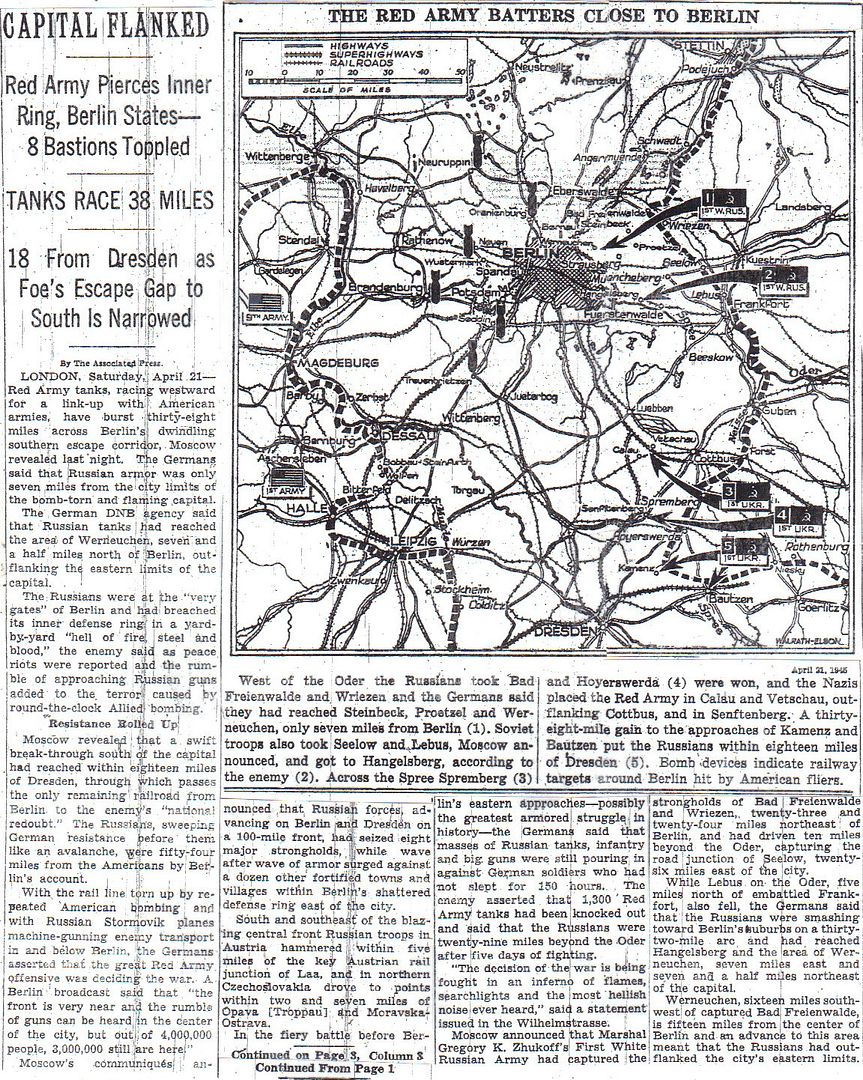
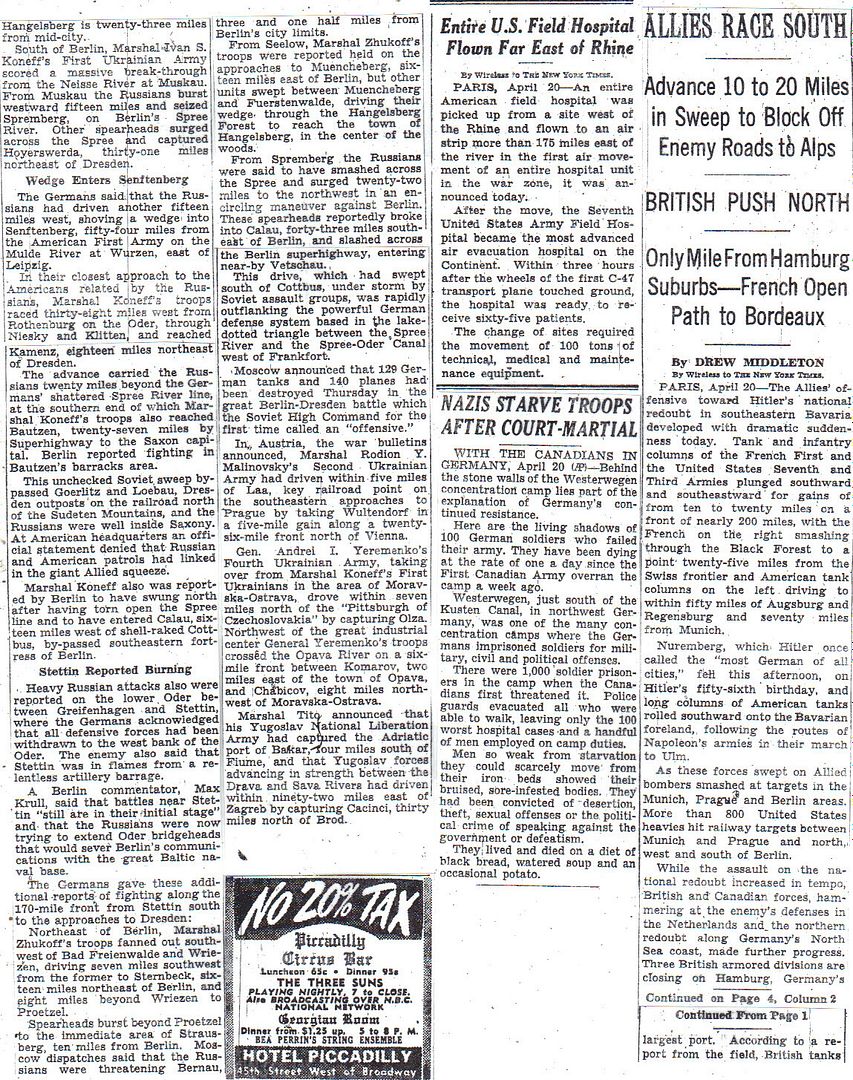
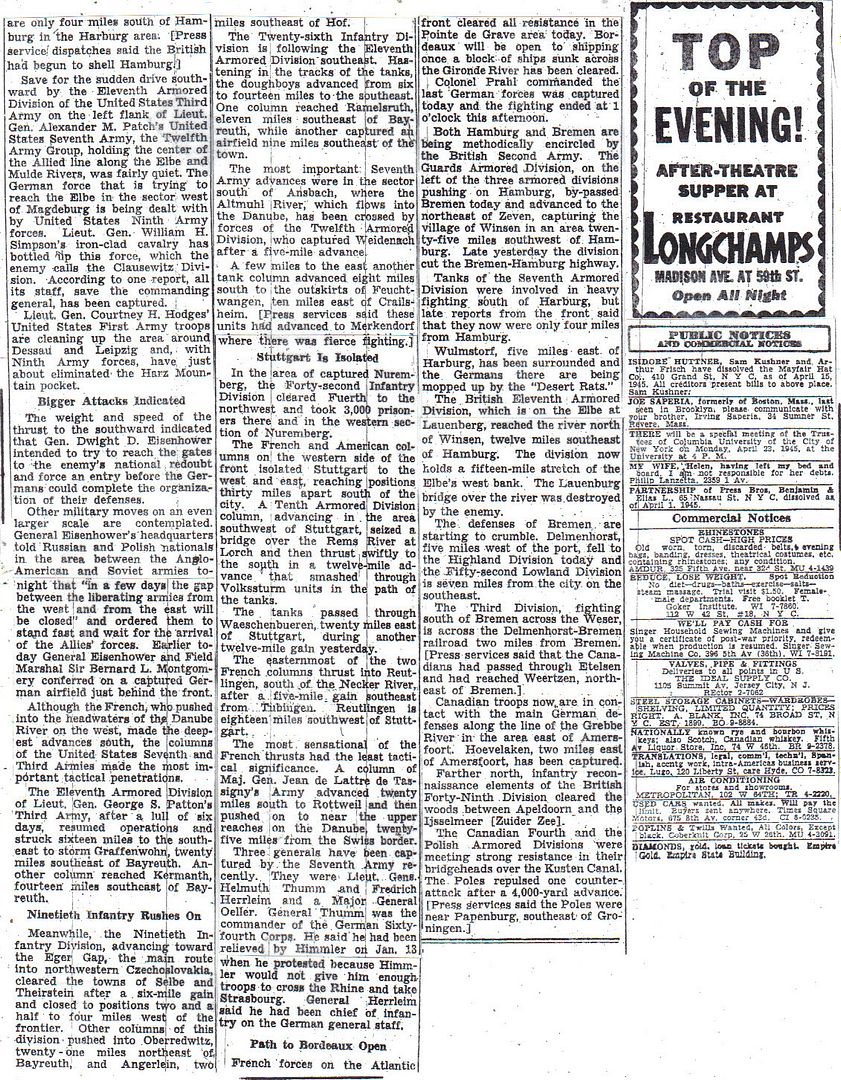
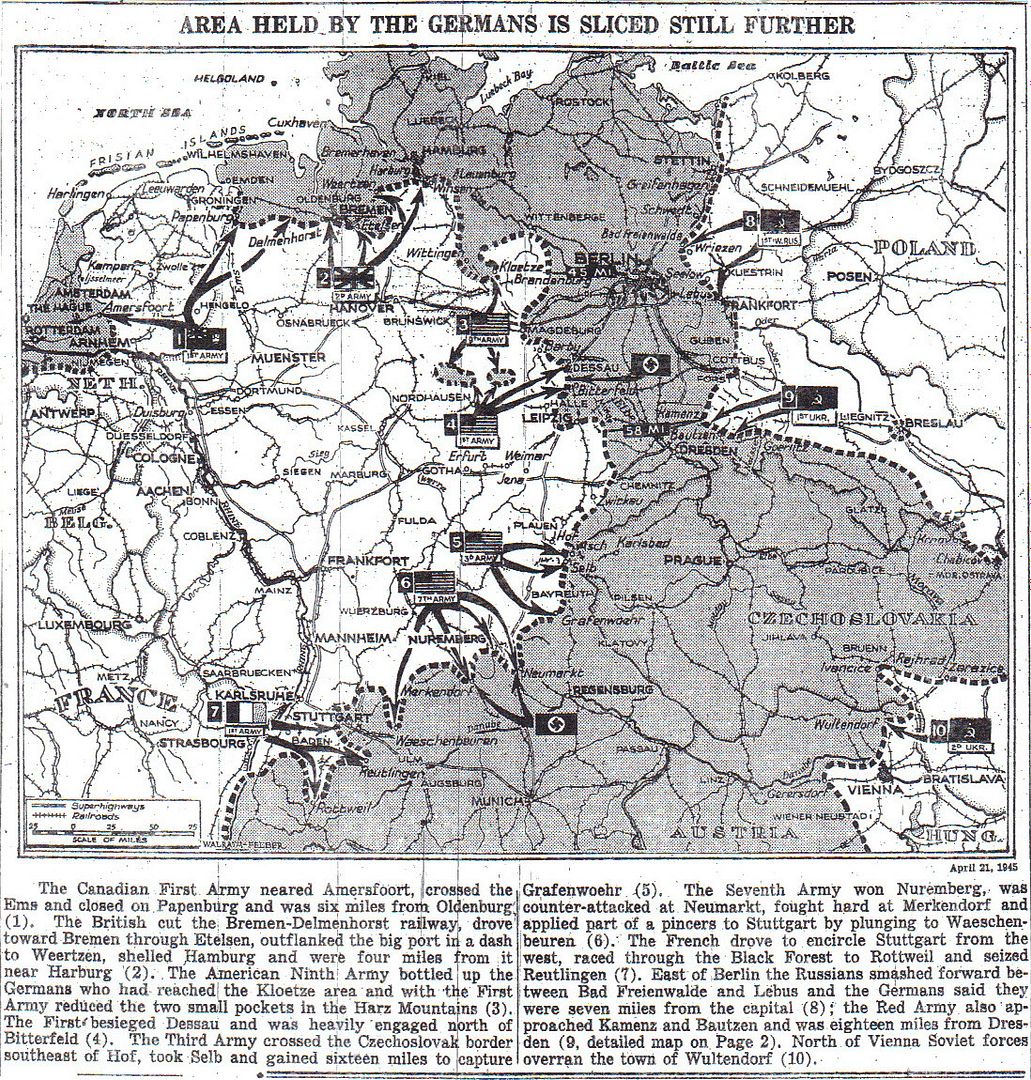

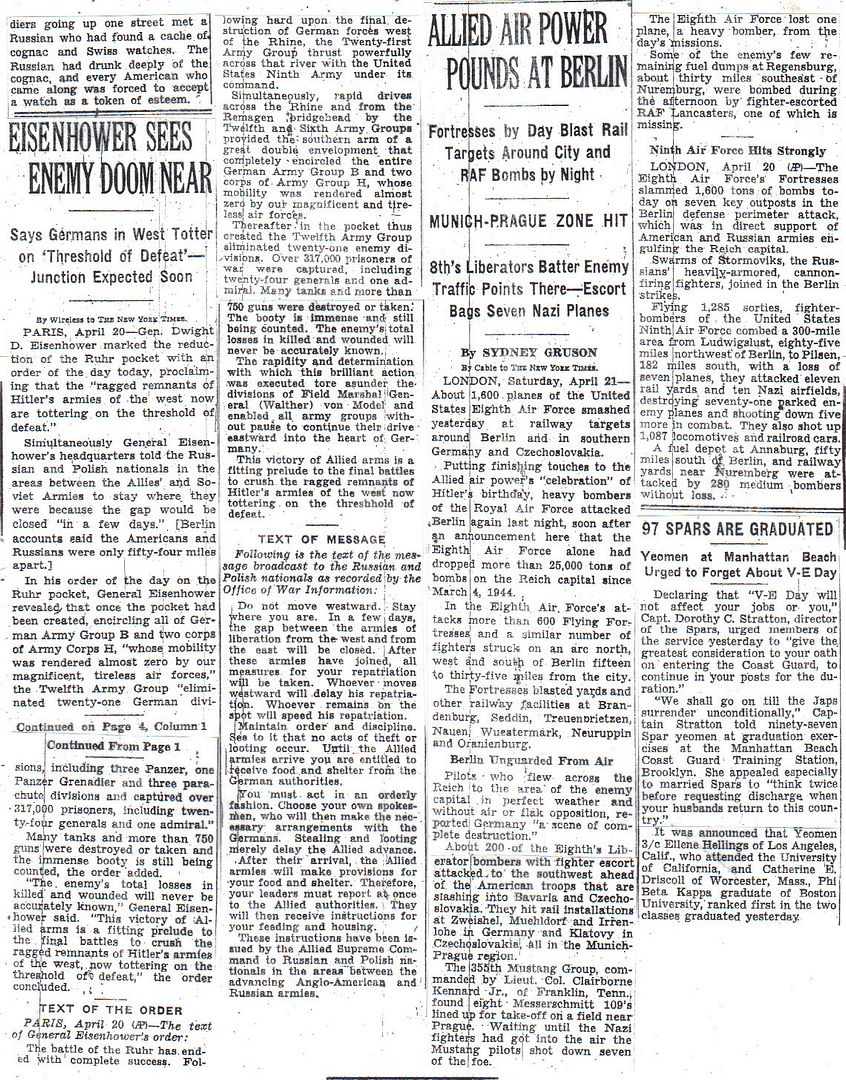
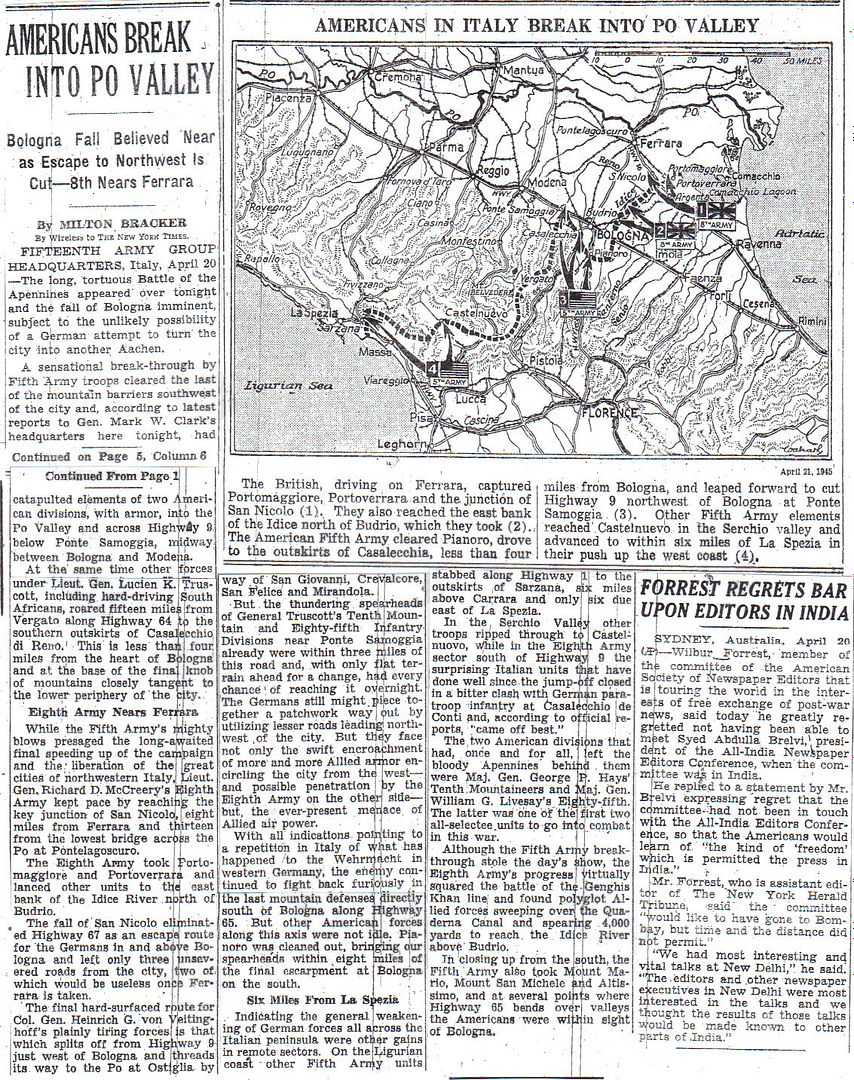
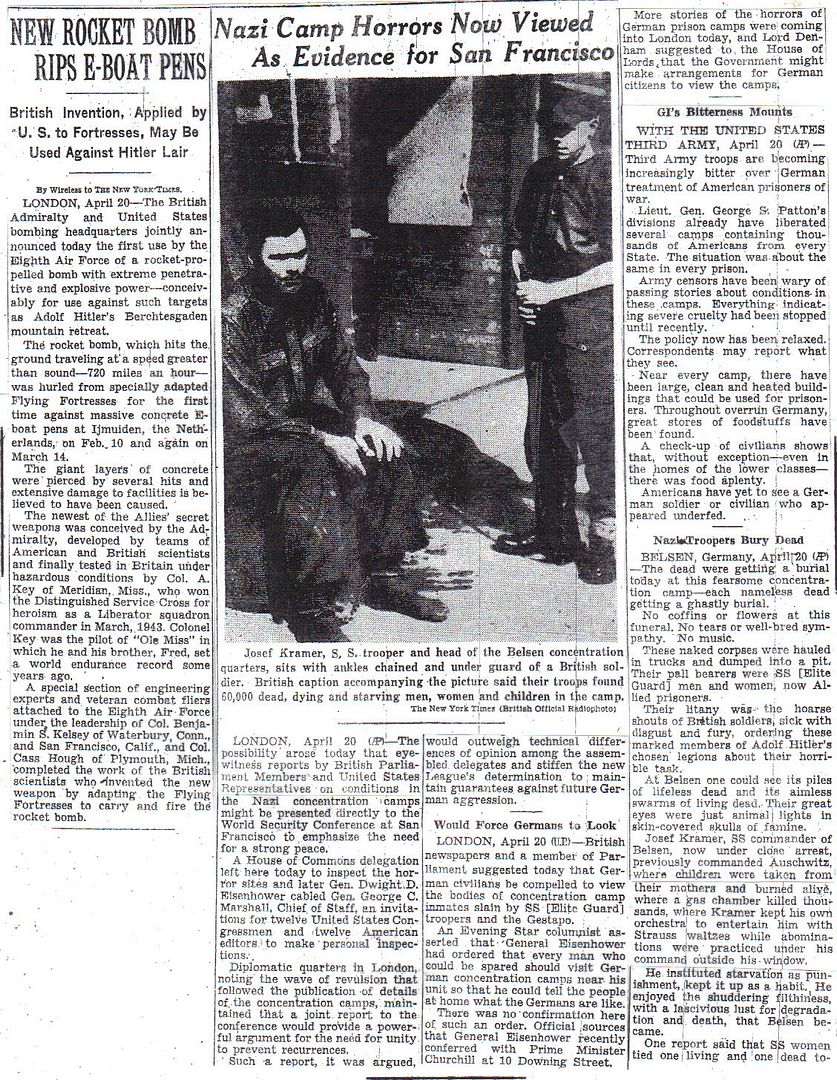
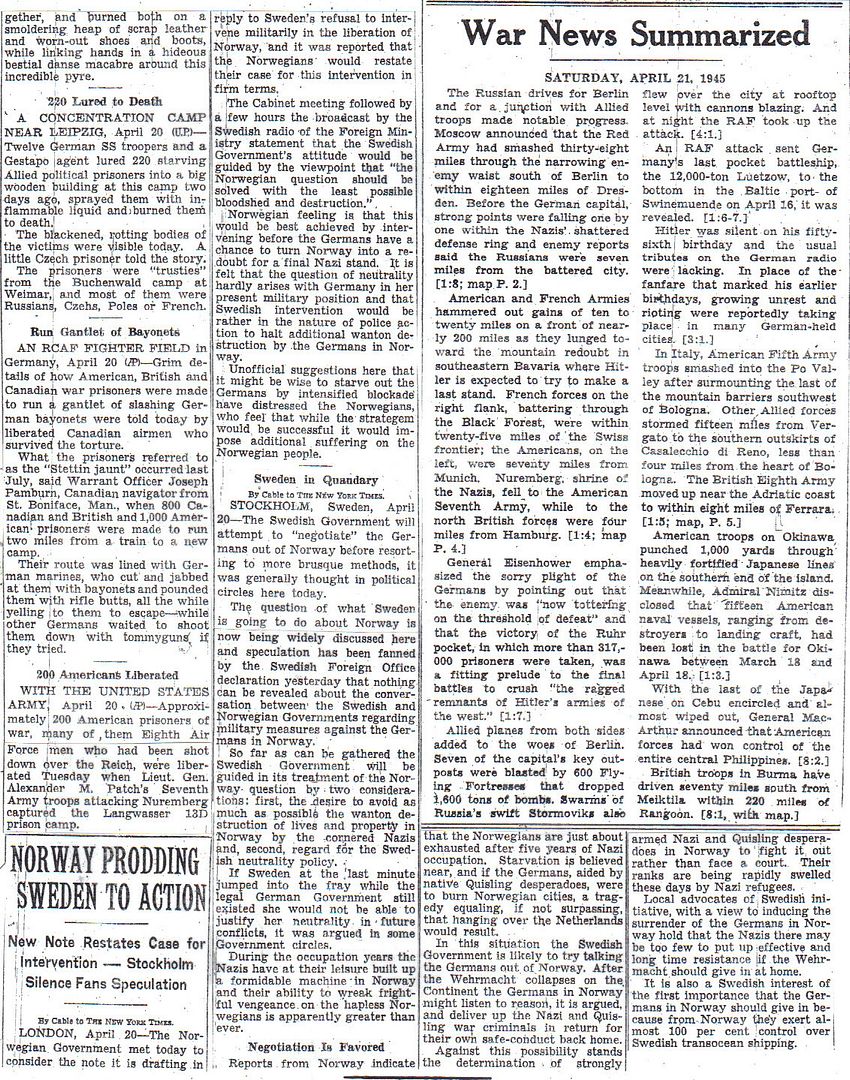

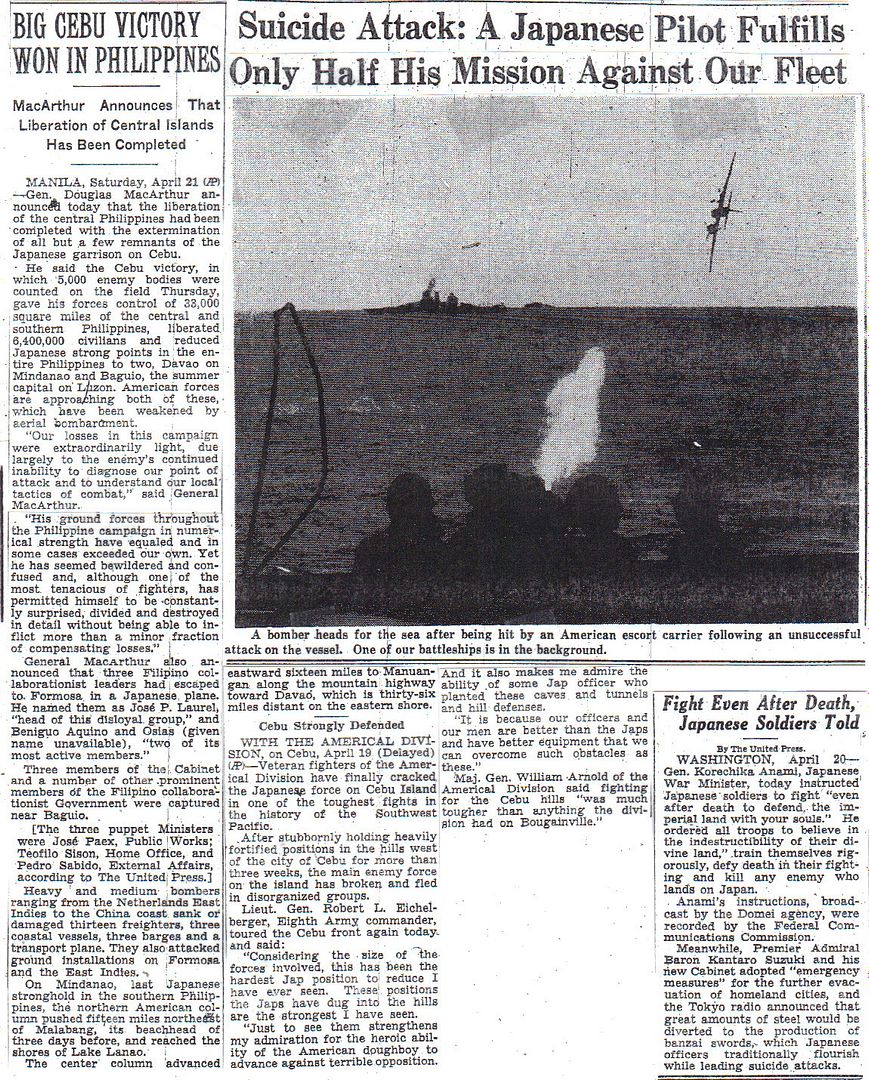

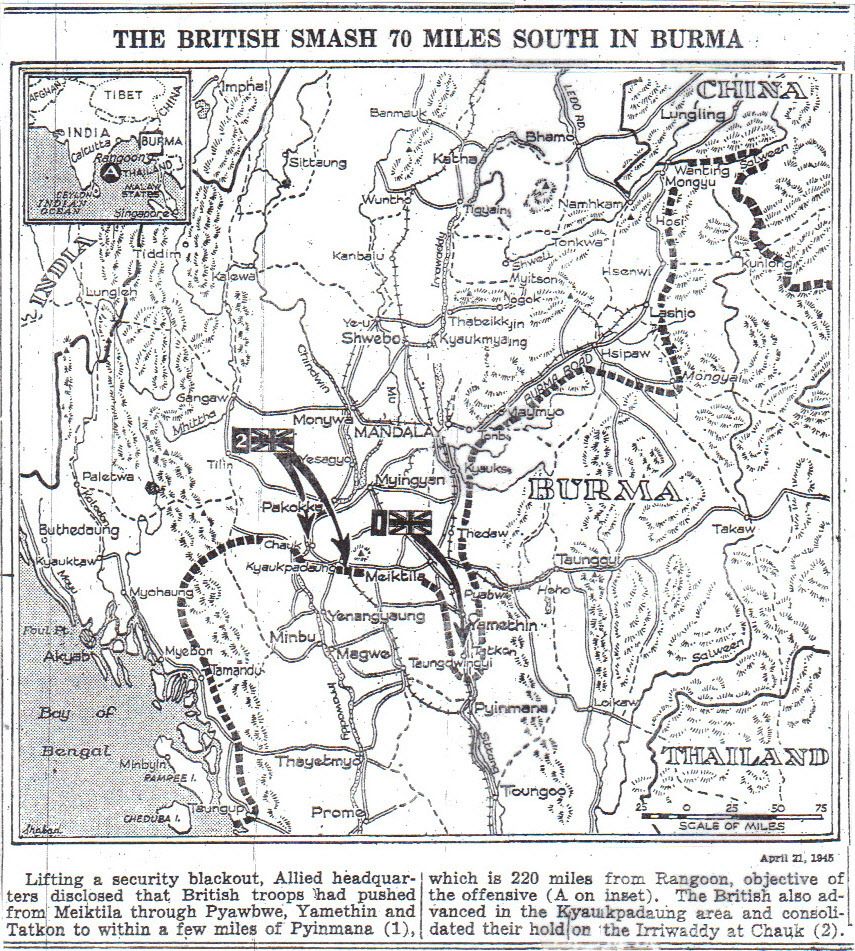
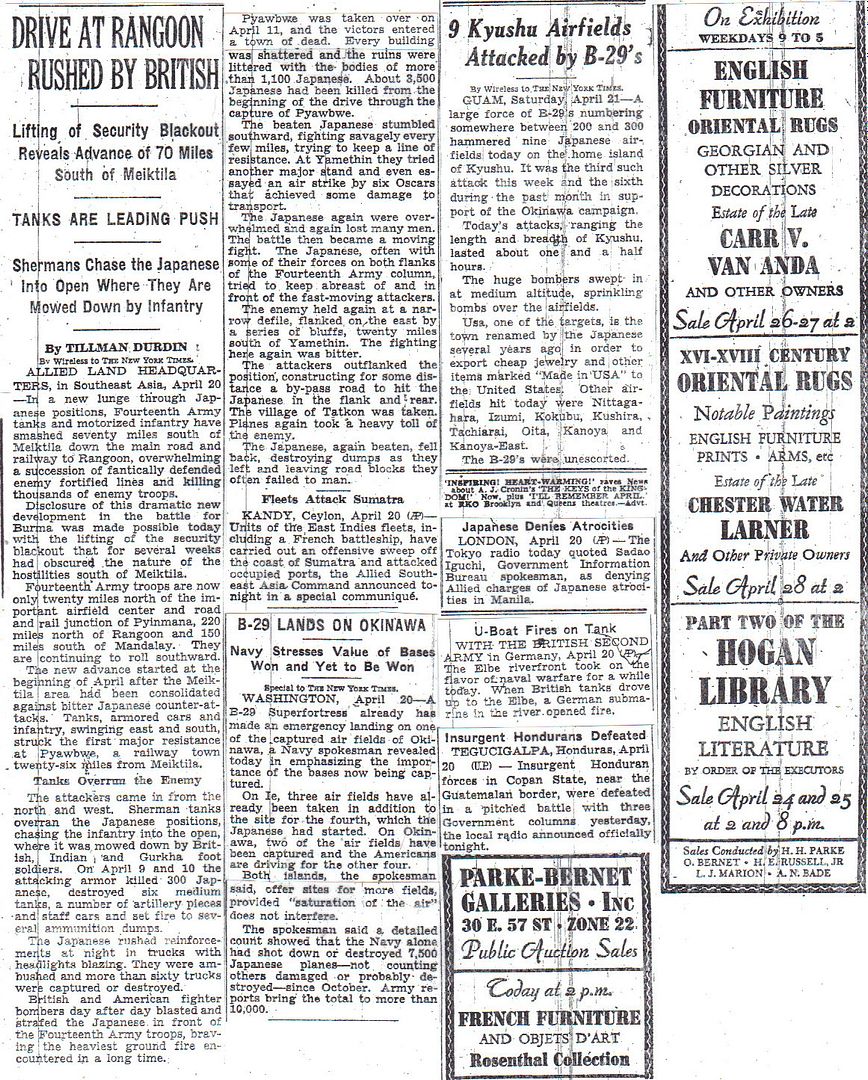
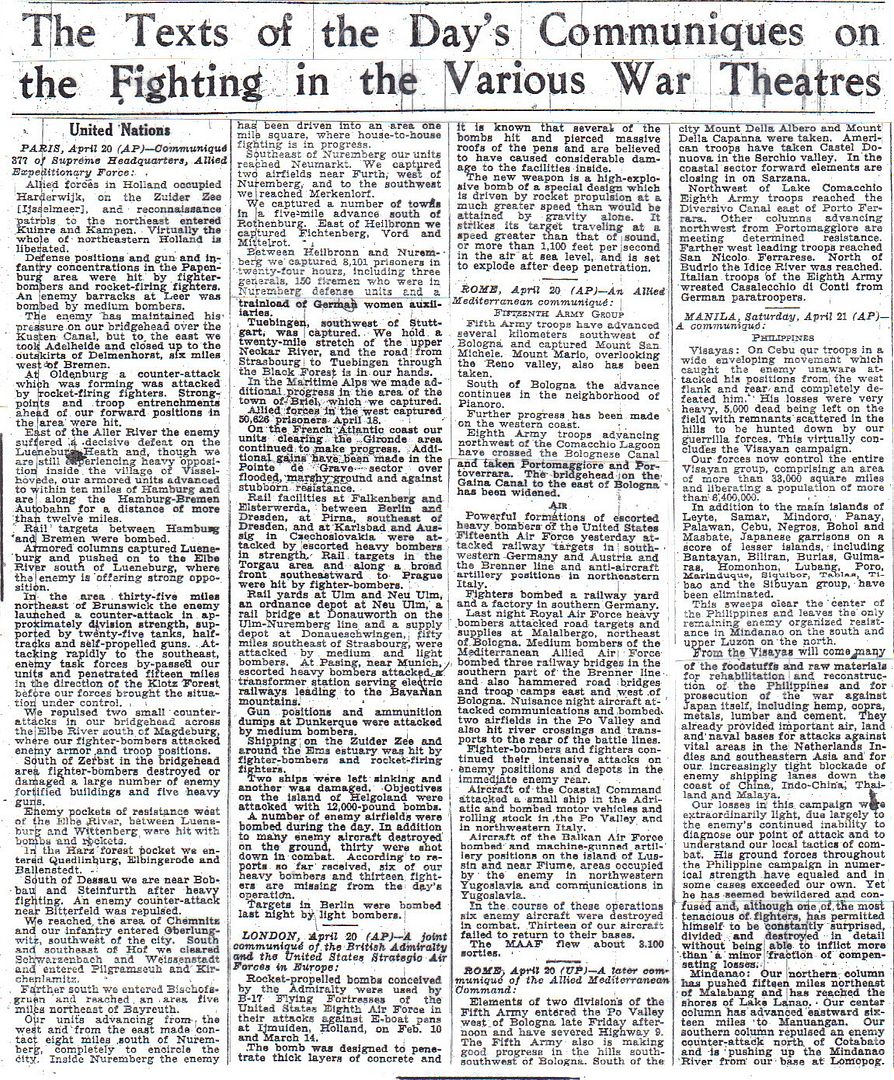

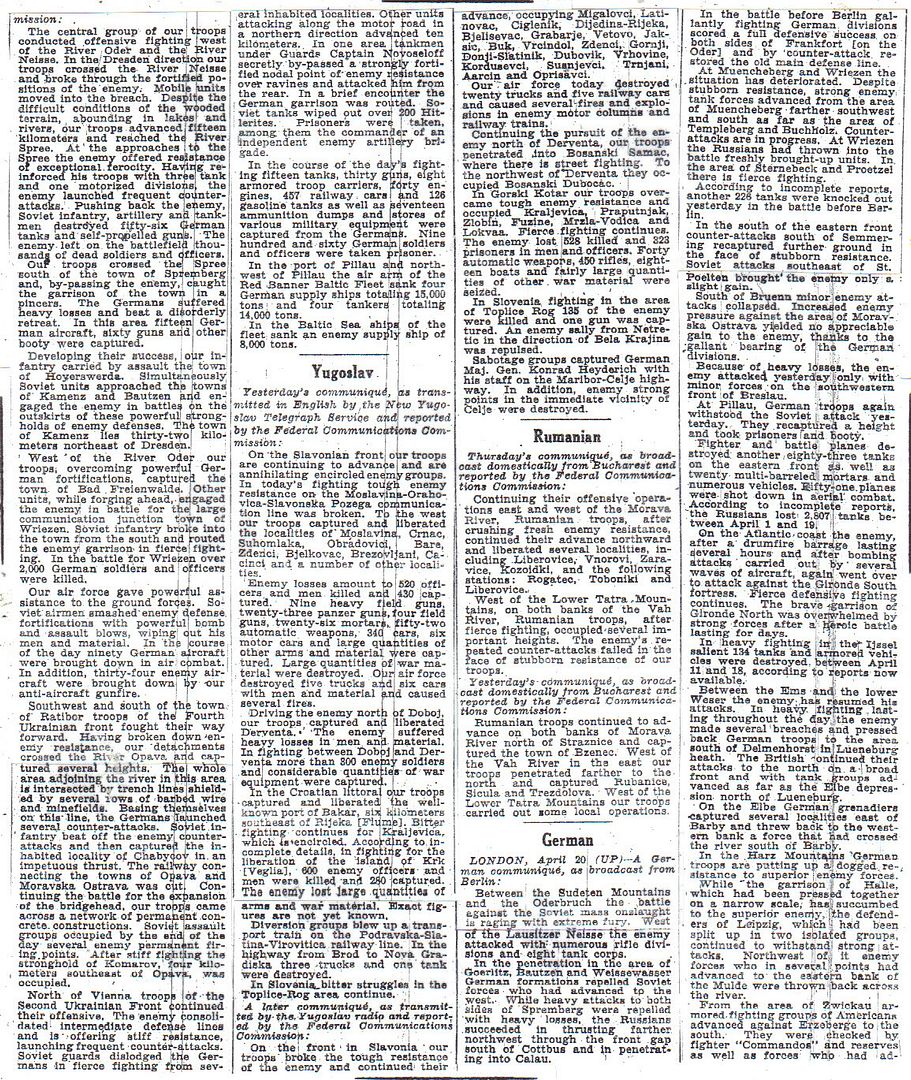
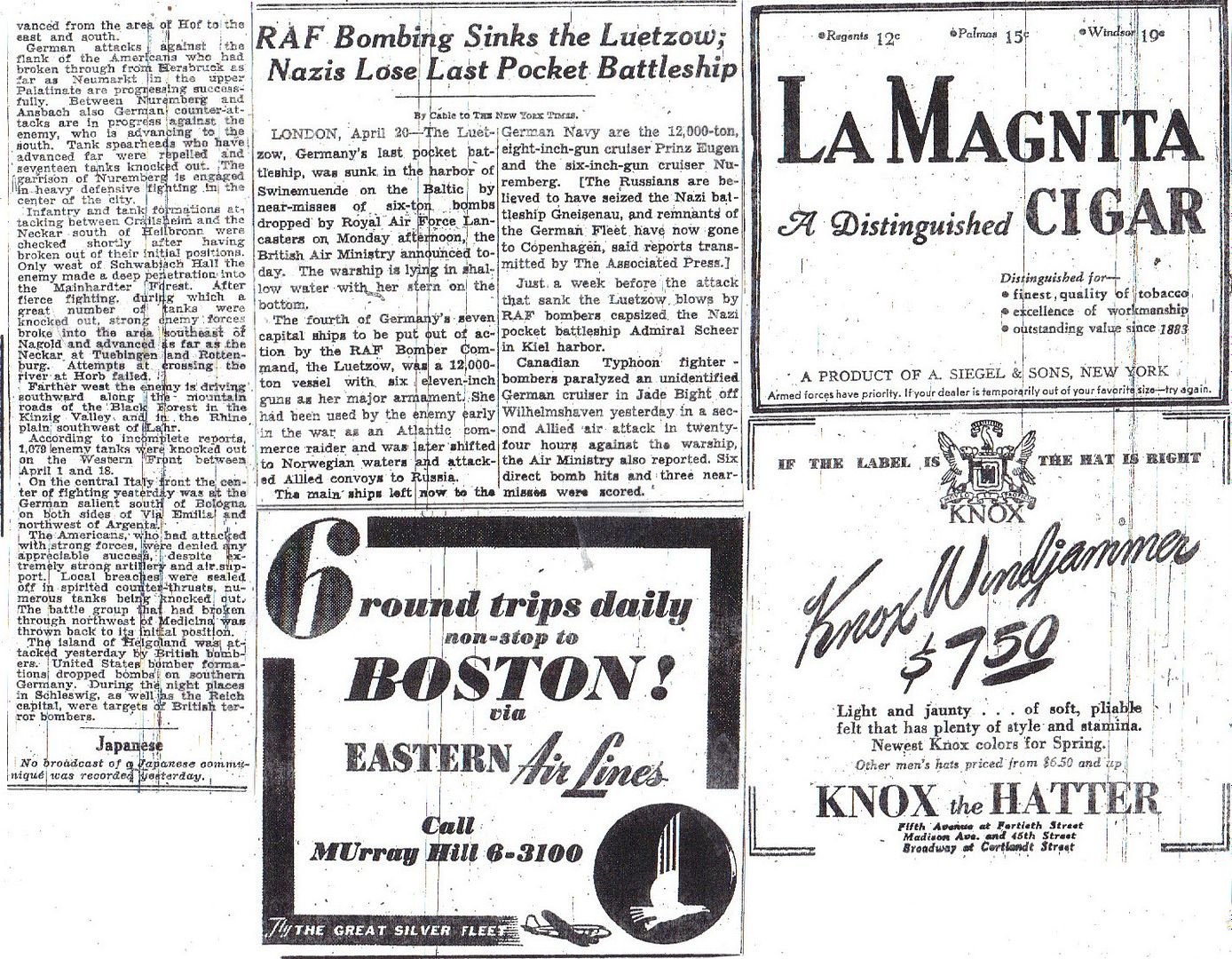
#1 - “My Dreams are Getting Better All the Time” - Les Brown, with Doris Day
#2 - “Candy” - Johnny Mercer, with Jo Stafford and the Pied Pipers
#3 – “My Dreams are Getting Better All the Time” - Johnny Long, with Dick Robertson
#4 – “Just A Prayer Away” – Bing Crosby and Ethel Smith
#5 - “I’m Beginning to See the Light” - Harry James, with Kitty Kallen
#6 - “Rum and Coca-Cola” - Andrews Sisters
#7 – “There! I’ve Said It Again” – Vaughn Monroe
#8 - “Dream” - Pied Pipers
#8 – “Sentimental Journey” – Les Brown, with Doris Day
#9 - “I’m Beginning to See the Light” - Duke Ellington, with Joya Sherrill
#10 - “My Dreams are Getting Better All the Time” - Phil Moore Four
http://www.etherit.co.uk/month/3/21.htm
April 21st, 1945
UNITED KINGDOM: London: Churchill’s fears about Stalin’s post-war ambitions grew today with news of the signing of a mutual assistance pact between the USSR and its client Polish government based in Lublin. Meeting in Washington, the Big Three’s foreign ministers, Eden, Stettinius and Molotov, have set out their positions, with Britain and America insisting on the widening of the government into one of National Unity.
Molotov refuses to budge, and Eden has written to Churchill: “No sign of progress. My impression is that the Soviet government is still cavalier in its attitude and will not accept the seriousness of the situation, unless it is brought up sharply against realities.”
Frigate HMCS Royalmount and corvette HMCS Orangeville departed UK with escort for Convoy ONS-48.
Frigate HMCS St Pierre arrived Londonderry with convoy SC-172.
GERMANY: Zhukov’s leading units reach the Berlin suburbs.
In the East: the Soviet 1st Ukrainian Front captures Bautzen and Cottbus 70 miles (113 km) southeast of Berlin while Soviet forces fighting south of Berlin, at Zossen, assault the headquarters of the German High Command.
The only remaining opposing “force” to the Russian invasion of Berlin are the “battle groups” of Hitler Youth, teenagers with anti-tank guns, strategically placed in parks and suburban streets. In a battle at Eggersdorf, 70 of these Hitler teens strove to fight off a Russian assault with a mere three anti-tank guns. They were bulldozed by Russian tanks and infantry.
The town of Treuenbrietzen is occupied by the Russians.
In East Prussia, remnants of AOK Ostpreussen (von Saucken) are still resisting in the port of Pillau, the Frische Nehrung and the Vistula delta between Danzig and Marienburg.
Hitler announces he will remain in Berlin. Göring, Himmler and other top Nazis flee so they can surrender to the Americans or British.
Göring takes his last trip by his personal train ASIEN. From Karinhall he travels to Berchtesgaden to his lodge on the Obersalzberg.
In the West, Stuttgart is overrun by De Lattre de Tassigny’s 1st French Army while there is continued German resistance around Elbingerode in the Harz Mountains.
British Guardsman Edward Charlton is later posthumously awarded the last Victoria Cross of the war for saving the lives of several men trapped in their tank during a battle in the village of Wistedt. He is so badly wounded during his act of heroism that he dies shortly after being taken prisoner. A total of 182 Victoria Crosses—Britain’s highest honour for valour—were finally awarded for World War II.
The Eighth Air Force flies Mission 963: 532 bombers and 444 fighters are dispatched to attack jet fighter airfields and rail targets in south-eastern Germany; 2 bombers and 2 fighters are lost:
- 111 B-17s hit the marshalling yard at Munich, a target of last resort, with H2X radar. Escorting are 90 P-51s.
- 186 B-24s are sent to hit the Salzburg marshalling yard and rail bridge but abort the mission due to 10/10 cloud cover; 1 B-24 is lost. The escort is 99 P-51s.
- 6 B-17s hit the secondary target, the Amlech Airfield at Landsberg; 212 hit a target of last resort, the town of Ingolstadt; 1 B-17 is lost. 144 P-51s escort; 2 are lost.
The lost B-24 was the last American bomber shot down over Germany during World War II. The ‘Black Cat’ was hit at 22,000 feet and broke into pieces.
One of the crewmembers was Howard Goodner.
Twenty-one year old Goodner had no parachute. He came down in freefall alongside bombs and oxygen tanks, spinning toward the Bavarian village of Scharmassing.
He landed in a field outside the town, his body striking the earth so hard that it left a crater nearly six inches deep.
Maria Wittig, then 19, saw him there. He was athletic looking, fair-skinned, handsome. Long fingers.
“I can see him before me,” she told an interviewer, a half century later, so clear was her memory. Shown a picture of the entire crew, she picked out Goodner immediately. “That’s him,” she said, her voice breaking. (Drew Philip Halevy)
The Ninth Air Force dispatches 121 B-26 Marauders to hit the Attnang-Puchheim marshalling yard; fighters fly escort, patrols, armed reconnaissance and cooperate with the US VIII Corps as elements of the 6th Cavalry Group cross the Czechoslovakian border to reach Hranice and Trojmezi, the XII Corps in the Grafenwohr-Weiden area, and the XX Corps east of Nurnberg.
Fifteenth Air Force bombers bomb the marshalling yard at Rosenheim while 138 P-38s bomb railroad lines and facilities in the Munich and Rosenheim, Germany-Rattenberg, Austria areas
Wustrow: Himmler meets Norbert Masur of the World Jewish Congress and refuses to free the Jews under his control.
Ruhr: Three days ago the commander of German forces in the Ruhr, Field Marshal Walter Model, drove to the forest beyond Dusseldorf, left his car, drew his service pistol and shot himself. A few months ago, when he took over the western command, he issued a ringing call to battle: “None of us gives up a square foot of German soil while still alive ... Long live our Germany and our beloved Führer!”
Now the Battle of the Ruhr has ended, with 325,000 prisoners in Allied hands; these include 30 generals and an admiral. Eisenhower, in an order of the day, says that “21 enemy divisions, including three Panzer, one Panzergrenadier and three Parachute divisions” have been smashed.
During an air raid on Kiel, U-2539 commander Oblt Erich Jewinski was killed.
U-2552 commissioned.
AUSTRIA: Weather curtails daytime operations but Twelfth Air Force B-25s score hits on the Matrei am Brenner bridge on the Brenner rail line.
About 200 Fifteenth Air Force bombers, with P-51 escort, bomb marshalling yards at Attnang-Puchheim, Spittal an der Drau, and Vocklabruck.
NORWAY: U-2511 put in to Bergen with diesel engine trouble.
U.S.S.R.: A Mutual Assistance Pact between the USSR and the Lublin Polish Government is signed.
ITALY: Bologna is captured by the Polish II Corps.
It was 5.50am when the last of the German garrison motored out of this university city. Bologna slept. Fifteen minutes later, advance units of the Polish II Corps drove in from the east and hoisted their national flag on the town hall, just a few minutes before American tanks rumbled in from the north, soon to be joined by Italian troops of the Eighth Army, their British steel helmets adorned with flowers and feathers.
Only then did Bologna awake to go noisily, crazily, mad with joy and relief. A stiff street-by-street battle had been expected. The German commander had received the now almost rubber-stamped order to fight to the last man. Instead, it seems that he made a deal with the city’s archbishop and the Fascist mayor. If partisans did not molest his retreating troops, he would not demolish Bologna’s public services.
As the Poles advanced along the Via Emilia, a coded signal had to be sent to the partisans to rise up. Anticipating this, the Germans arrested and shot two of their leaders. Today, as Bologna went wild, the partisans shot two leading Fascists in revenge.
San Terenzo: US 2nd Lt. Daniel K. Inouye (442nd Infantry) while leading his platoon in an attack on German positions on Mount Musatello, performs acts of heroism which later result in him being awarded the MOH. Inouye is wounded in the right arm by a grenade and the right leg by another bullet.
During the night of 20/21 April, Twelfth Air Force A-20s and A-26 Invaders bomb Po River crossings with good results and in the late afternoon hit Po River crossings; XXII Tactical Air Command fighters and fighter bombers, grounded most of the day, fly close support to the US Fifth Army which drives into Bologna (a longstanding objective) and begins to push rapidly across the plain toward the Po River.
ARCTIC OCEAN: In the Arctic Sea, an Allied U-boat hunter group attacked U-997 with depth charges. Due to some damage to the periscope, the boat had to return to base.
BURMA: Bad weather over central Burma causes cancelling or aborting of all Tenth Air Force combat missions however, transports complete 464 sorties, landing or dropping 682 tons of supplies to forward areas.
CHINA: 5 Fourteenth Air Force B-25s bomb Loyang; a single B-24 hits targets of opportunity in Bakli Bay on Hainan Island; 30 P-51s and P-47s attack railroad and road targets, barracks area, buildings, and bridges at or near Paoching, Chihsien, Taiku, Hsihhsiassuchi, Shaho, Linfen, Luan, Yutze, and Shanhsien. C-47 Skytrains commence Operation ROOSTER, the movement by air of a Chinese infantry division to the Chichiang area.
NETHERLANDS EAST INDIES: On Borneo, Thirteenth Air Force B-24s bomb Miri, Kudat, Manggar, and Sepinggang Airfields and P-38s hit Tarakan Island and Sandakan, Miri Airfield, oil storage near Lutong, and, with B-24s, attack targets of opportunity along the southwest Celebes coast. USN PV Venturas also attack various targets on Borneo.
U-183 sailed from Surabaya on her final patrol.
COMMONWEALTH OF THE PHILIPPINES: The US 37th Division makes some gains in heavy fighting near Baguio, Luzon.
The Fifth and Thirteenth Air Force continue large scale support of ground forces on Luzon, Cebu, Negros, and Jolo Islands. USMC F4U Corsairs and SBD Dauntlesses attack highways and roads supporting the US X Corps on Mindanao. USMC SBDs also attack Japanese positions on Mount Daho on Jolo Island.
RYUKYU ISLANDS: Organized Japanese resistance on Ie Shima ends. Nearly 5,000 Japanese have been killed, 149 captured. The Americans have suffered 1,000 casualties.
JAPAN: The XXI Bomber Command flies Missions 82 to 90 bombing airfields in Japan; 217 B-29 Superfortresses blast airfields at Oita, 2 at Kanoya, Usa, Kokubu, Kushira, Tachiarai, Izumi, and Nittagahara; 21 other B-29s hit targets of opportunity including the city of Kagoshima.
Off Okinawa, the destroyer USS Ammen (DD-527) is damaged by a bomb that misses.
NORTH PACIFIC: 18 Seventh Air Force Guam Island-based B-24s bomb Marcus Island.
U.S.A.: Minesweeper USS Wheatear launched.
ATLANTIC OCEAN: U-636 sunk in the North Atlantic west of Ireland, in position 55.50N, 10.31W, by depth charges from frigates HMS Bazely, Drury and Bentinck. 42 dead (all hands lost).
The battle for Berlin was a bloodbath. And not just for the Germans. Stalin had no regard for human life, not even the lives of his own troops.
Some time back I posted a couple of stories about the massive, but ineffective, Allied air attacks on the German High Command headquarters facilities south of Berlin at Zossen.
Well, the Soviets have now taken Zossen.
Located 25 miles south of Berlin, the Zossen underground complex of bunkers and tunnels served as the protected communications nerve center first for the German armies under Adolph Hitler’s command and later for the Russian forces occupying East Germany.
Originally cleared as a firing range and infantry school, by 1914, the 60,000-acre area had become Europe’s largest military base, dotted with handsome buildings, some of which survive to this day. Bunker complexes called “Maybach” (a command center) and “Zeppelin” (communications) were built beginning in 1934 by the Nazi regime. The initial communications links constructed in 1934–1935 involved considerable redundancy to better withstand air attack. The Zossen bunker complex was well connected with subterranean links to the military commands in central Berlin, and to a trunk cable ring buried around the city. Priority construction of the Zeppelin bunker in 1937– 1939 involved installation of dozens of massive telephone and telegraph switchboards. Most were operational by August 1939 in time for the German attack on Poland. Radio facilities were also added. Substantial battery backups guaranteed continued operation even with loss of the electric power grid due to air attack. The Allies never discovered the existence of these backups until after the war and bomb damage was largely superficial, indicating that the backups had not been targets.
Allied interrogators were aware of the Zossen compound as early as July 1944 by virtue of an interrogation of a Feldwebel who was captured in Italy. The Feldwebel had served at Zossen for some time and gave his interrogators considerable information about the facility, although the extent of the communications system does not appear to have been emphasized in this particular report.
Fast-moving Soviet forces occupied the virtually intact Zossen bunker facilities on 20 April 1945. Some German officers - with a view beyond Götterdämmerung - had the good sense to display large placards in Russian, in and around that telephone exchange saying This equipment is NOT to be destroyed or tampered with! A foresight that served postwar communications in the chaos very well. Most equipment was dismantled (often quickly and thus badly) and shipped back to the Soviet Union.
http://germspeer.blogspot.com/2009/02/zossen-germany-wwii.html

Nuremberg, Apr 21 1945
Mission map for 4-21-45 (#191) - 486th Bombardment Group
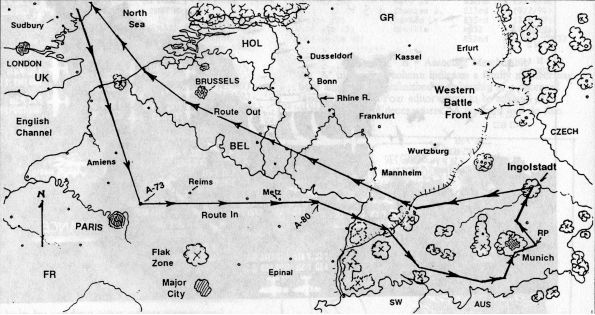
8th AF raids on German airfields forced many units to scramble for alternate landing fields. Beaten, but not yet defeated, many units continued to fly combat missions to stem the allied tide. Intelligence reports indicated that a unit of German jet fighters (most likely JV 44 commanded by LTGEN Adolf Galland) was using the Autobahn as a landing strip. Their normal airfield near München-Riems had been bombed forcing the jets to the highways.
To prevent these jets from launching attacks against Patton's advancing army the 8th AF was tasked to take out the ad hoc airfield. The 486th was to provide 3 squadrons and would lead the 4th Combat Bombardment Wing on this mission, which would only involve 800 heavy bombers. The Wing would be in the second position in the 3rd Air Division bomber stream. Mission details and field orders were received at 0200 hours on April 21, 1945 and the targets were: Primary - Autobahn; Seconday - Marshall yards and airfields in the München area.
LTCOL Dick Uhle was the Air commander for the group and wing. CAPT McAnelly was assigned to lead the high Squadron and CAPT Hodges lead the low squadron. Twenty-nine aircraft from all 4 squadrons were prepared for the mission, but only the 832nd (hig), 833rd (low) and 835th (lead) squadrons flew the mission. Crew briefings were begun at 0330 hours by CAPT Whitney, LT Zabara, LT Sherman and MAJ Morriss (S-2).
Take off was scheduled for 0630 hours, with the last aircraft off the ground by 0715. A haze layer covered England, but would not affect assembly, which would be over the continent. The planes entered the Channel airspace over Felixstow and made landfall just North of Calais. The aircraft avoided the still operational FLAK batteries near Dunkirk and headed for Buncher A-73 near Paris where the bomber stream assembled. The assembly proceeded smoothly in spite of a non-functioning beacon.
The bomber stream arrived at checkpoint A-80 one minute early. The stream began a climb to 20,000 ft early because of the weather over the area. The clouds also forced the Air Leader to divert the stream from the pre-planned flight path. The weather prevented the 8th AF from reaching the assigned bombing altitude and the stream reached the IP at 19,000 ft.
The weather demanded the bombers to fan out and proceed to the targets in squadrons. The cloud cover prevented bombing of the primary target, which was to be bombed visually only. The bombers rallied and continued to the secondary on course, which was also obscured by clouds and not bombed. The Rally point (RP) became the IP for the tertiary targets.
The 486th made bombs away, but clouds prevented direct observation of the results. The 94th Bomb Group made their drop from a higher altitude near the 486th. No aircraft were endangered. The two bomb groups were able to manuever around each other and made the Rally Point for the return flight home.
The weather required the bombers to deviate from the planned route home. After 10 hours in the air, the group arrived over Sudbury and the last aircraft landed at 1635 hours. The mission was flown without fighter opposition nor FLAK. The group was commended for flying a good mission in adverse weather conditions.
(source: O&W N/L Spring 95)
http://www.3ad.com/history/wwll/feature.pages/super.pershing.1.htm
DUEL AT DESSAU
3AD’s “Super Pershing” vs. Germany’s “King Tiger”
WWII’s two most powerful tanks meet in a historic encounter
April 21, 1945
Only three days before the 3rd Armored Division’s final combat action of WWII, a Super Pershing of the 33rd Armored Regiment met and defeated the most powerful and most heavily armored German tank of the war - the legendary 77-ton King Tiger, also known as the Tiger II or Tiger Royal. It would be the first and only meeting between a King Tiger and the Super Pershing, a modified standard M26 Pershing weighing 7 tons heavier at 53 tons - an almost “secret” tank that, to this day, remains largely an enigma to military historians.
Only two Super Pershings were ever built, and the 3AD had the only one in the European Theater - an experimental version with its remarkably long barrel. Arriving very late in the war (March, 1945), it was field tested and modified inside Germany and subsequently saw about ten days of actual combat action, beginning several days after the Battle of Paderborn and ending with the Battle of Dessau near the Elbe River.
The Super Pershing (aka T26E4-1) was equipped with a new long-barreled T15E1 90mm gun that was designed to out-perform the German high-velocity 88mm on the King Tiger. In testing, this new U.S. gun had successfully penetrated 8.5 inches of armor at 1,000 yards at 30 degrees. Even more remarkable, it had penetrated 13 inches of armor at 100 yards. The special 90mm ammunition had produced a muzzle velocity of 3,850 feet per second, or some 600 feet per second faster than the 88mm of the King Tiger. The new 90mm round also proved to have superior range and accuracy over the previous version.
Army ordnance technicians (in the U.S. and Europe) had been anxious about getting the new tank into combat, hoping to match it against a King Tiger. But by April, 1945, German armor west of Berlin had dramatically thinned out, not to mention an extreme shortage of fuel, and the odds of spotting the monster German tank were slim. But in Dessau on April 21, “luck” would befall the Super Pershing crew commanded by SSgt Joe Maduri, a veteran 3AD tanker in his tenth straight month of combat.
The 3AD had begun a four-pronged attack on the city, which was heavily defended. Division armor were finally able to enter the city slowly after numerous concrete tank barriers were destroyed. With 3AD tanks fanning out, and 36th Infantry riflemen following, the Super Pershing reached an intersection and began to round a corner to its right. Unknown to its crew, a King Tiger had apparently been waiting in ambush at a distance of two blocks or roughly 600 yards away, and in the same direction that the Americans were turning into.
At this distance, easily within its capability, the Tiger fired at the Super Pershing. But its infamous high-velocity 88mm shell, of the type that had destroyed so many American tanks and vehicles during the war, went high and was not even close. Gunner Cpl John “Jack” Irwin, only 18 years old, responded almost instantly with a round that struck the Tiger’s huge angled glasis, or front plate. But the shot, a non-armor-piercing high explosive (HE) shell, had no effect. Ricocheting off the armor, it shot skyward and exploded harmlessly. The Super Pershing had been loaded with an HE only because Irwin had been expecting urban targets, such as buildings, personnel, and light anti-tank guns. “AP!”, he shouted to his loader “Pete,” which meant an armor-piercing shell would be next.
Maduri and crew then felt a concussion or thud on the turret. It was never known if this shot came from the Tiger, or from some other anti-tank weapon. In any case, no serious damage was done - probably a lucky glancing impact. In the next instant, Irwin aimed and fired a second time, just as the royal monster was moving forward and raising up over a pile of rubble. The 90mm AP round penetrated the Tiger’s underbelly, apparently striking the ammo well and resulting in a tremendous explosion that blew its turret loose. With near certainty, the entire crew was killed.
But there was no time to examine their “trophy.” A battle was raging, and the Super Pershing continued down the street, passing the lifeless and burning King Tiger. Tough fighting still lay ahead, as German bazooka, Panzerfaust, and machine-gun fire came from windows and doorways.
The encounter with the King Tiger had been “short and sweet,” lasting less than twenty seconds. It may not have been the titanic “slug fest” that could have occurred on an open field, but it was an overwhelming victory for the quick-reacting Super Pershing crew. The battle for Dessau would end completely on the following day, but not without the Super Pershing destroying another German heavy tank (believed to be a 50-ton Panther Mark V) with two shots. The first disabling its drive sprocket, and the second round completely penetrating the tank’s side armor. That apparently set off an internal blast, again probably from stored ammo. And, still in Dessau, that was followed by Maduri and crew forcing the commander of a German medium tank to surrender without firing a shot. For the German crew, out of ammo for their main gun, the intimidating “look” of that long-barrel 90mm gun that must have destroyed any remaining will to fight or flee.
[Note: Sources include the book Spearhead in the West (1946 edition); the book Death Traps by Belton Cooper; and the book Another River, Another Town and personal writings by John P. Irwin.]
More information at the link...
http://www.3ad.com/history/wwll/feature.pages/super.pershing.1.htm
Well, Walter Model killed himself. I guess that really does close out the Rose/Ruhr Pocket.

What's left of Nuremberg.
http://www.stalag-viiib.com/content/pow-diaries-1945-april-21-1945-jhhallam-stalag-viiib
P.O.W. Diaries 1945
J.H.Hallam
Stalag VIIIB
Saturday 21 April 1945
Wake early, only for to do a job. We eat our last tin of bully beaf for breakfast. Spuds 3 per man from Jerry, also a little flour soup. We move off at 11 o’clock. Have to push the bloody Jerries cart laden with their own kit. Up hill down hill, stop, go steady, what a trek. Rain fell heavily. Arrive at barn again, lucky have electric light here. I feel full of wind. Had two slices of bread. Might get a soup later.
http://profiles.nlm.nih.gov/ps/retrieve/ResourceMetadata/HPBBGF
Letter from Henry Swan to his first wife, Mary Fletcher
Intending to have them published, Swan’s wife had his letters transcribed as he sent them.
April 21, 1945
Darling,
I haven’t written for a day or so. I have been too depressed. The realization that what has occurred here is only one small incident among many others makes it even more terrible!
At Weimar and at Bremen we are told of massacres larger in numbers; but what I saw myself on my two visits to the charnel house at Gardelegen exceeds in cold-blooded brutality anything of which I have read or imagined to be possible. I am going to tell you the story, as well as it is known.
Every American should be brought to see with their own eyes this sight. They must be made to realize that this type of incident is true - it really happens. They must learn anew to recognize our Nazi enemy as the inhuman, despicable beast he is.
In East Prussia there was a concentration camp, where many thousand “enemies of the Reich” were imprisoned. Nobody knows exactly how many. Most of these people were there because they were patriots, and fought for their homes.
There was a Dutchman, an old and wealthy man, who gave sanctuary and aid to two American parachutists. They confiscated his wealth, and sent him to a concentration camp. This was in 1942. His sons are also “missing.”
There was a Russian tanker, a legitimate prisoner of war, who was considered important enough politically to be sent there.
There were many Poles whose crime was that they were Jews.
There were Frenchmen who either had been or were suspected of being active in the underground.
There was a French doctor, and it is thought, two English, or perhaps American, medical corpsmen.
There were about 50 women from various countries, no one knows for sure what had been their “crimes.” In all they numbered several thousand.
In January the Russian drive began to imperil this camp and it was decided to move the prisoners to inner Germany. They were packed tight in box-cars, and train-loads began to move west. It was very cold - many degrees below zero. These people had no coats or shoes. They wore gunny-sacks or rags.
One of these trains, the fate of whose occupants we follow, was spotted and strafed by allied plane. The engine was destroyed by a bomb. So, on about the 29th of January, began a two months’ march, which beggars the imagination. All day in the bitter cold they trudged through the ice and snow. At night they sank exhausted, and if they did not freeze to death, awoke to trudge again. Feet froze, hands froze, their souls froze. One of the survivors with whom I talked can not remember weeks at a time of this dreadful march. If one became too enfeebled to keep up , the Nazi guards shot them, or beat their brains in with the butt of a gun, or just left them to turn to icicles. They were fed one piece of black bread and one bowl of watery “soup” a day. Sometimes they were fed twice in a day.
It is thought by the survivors - there are five - that over half of those who started died on the way. All of the women died. Those who finally arrived here were gaunt, emaciated, shriveled specters of their former selves.
You have never seen a person who starved to death - until his skin, wrinkled and leathery, shrouds his bones, and his face is like a mummy. I have seen hundreds. It is not a sight one forgets.
When this dreadful march was over, they were put in several small concentration units near Gardelegen - at least, those who could still walk around. The weakest were put in “hospitals.” These consisted of a number of houses or buildings, where the prisoners lay on straw or on the floor in rows. They were occasionally fed. One or two were actually hospitalized in a military hospital there at the insistence of a French doctor.
This was the state of affairs as of about a week ago.
Then suddenly came news to the district party leader - the Kreisleiter - that the American armor was rapidly approaching. The exact details of what happened and exactly by whom was what done are not known. Obviously, witnesses are reticent, to say the least. (Two were so reticent as to commit suicide in their prison cell night before last).
But, as the story is pieced together, this is what happened.
The Kreisleiter, through the local SS and the party members, organized the Wolksturm of Gardelegen (that is, the people, the civilians, the German folk themselves). They went about a mile out of town to where there was a barn near the big airfield, about 150 feet long and 50 wide. Outside of this, to the north and east, they dug a series of trenches about 60 feet long, six feet wide and eight feet deep. The soil is sandy. It is not hard digging. They put straw in the barn, and soaked it with some oil. On Friday the 13th they were ready. They collected all these gaunt and tattered prisoners from the camps, the “hospitals”, the buildings, and assembled them at this barn, One Russian fell on the way. He was clubbed with the butt of a rifle, and left as dead. But the blow was a glancing one, and only lacerated the scalp. (He is one of the survivors). The old Dutchman had managed to escape during the last days of the march. He was hiding in a little farm-house, sheltered by some Russian slave-farm-laborers. (Thus he too survived). They had two machine guns strategically placed near the corners of the barn. The Wolksturm had rifles and pistols.
They asked is any of the prisoners could shoot a rifle. Some said they could. These they stood on a line about 15 yards from the barn, with Wolksturmer and SS standing behind them with pistols in their ribs.
The rest were herded into the barn. Some refused to go, knowing what was in store. These were shot. The rest were crowded in. Then the big wooden doors were slid shut. The ones with rifles were ordered to start shooting through the doors. The machine guns began to rattle. Some bazookas were fired through the walls. A 13 year old boy threw a burning faggot through a hole in the wall. The straw began to burn, and soon inside was an inferno — Then the prisoners who had had the rifles were shot in the back of the head. —
Saturday morning, the fire was still smoldering. The Wolksturm were trying to bury the evidence. Most of the bodies outside, and a few from inside had been thrown into the pits. But they couldn’t finish. The American armor swept into town in the early afternoon. The brick shell of the barn with its charred doors and grisly contents told its story all too clearly. The pits were only half full.
Do you think the Coconut Grove fire was a disaster? Listen! There were over six hundred bodies found in the barn. There were over 400 more already in the pits!
I went out to the barn on Wednesday. It is a sight to banish sleep. Emaciated bodies, twisted in grotesque shapes. Some charred, others just darkened by the smoke. Piled on top of each other, four, five, ten deep, especially near the doors and corners. One had dug with his hands a pit in the dirt of the doorway just enough so he could get his face out - struggling to get air to breath! The agony is frozen on his face. Some had others in their arms, as if to protect them. One oldish man was just a head on a body, The arms and legs were burned right off.
Can you visualize that scene as it took place, and hear the screams, and moans, the crackling fire, and the rattle of the machine-guns and rifles?
It seems hard to believe, but two or three people lived to come out of that barn alive. One lay unconscious under a pile of bodies until Sunday. They were in an Evac. Hospital near the town. I have seen them and talked to them through an interpreter. The Russian tanker will probably come out all right, and the other too will probably survive. One has gained over five pounds in as many days. Think, next time you eat a steak, what it might mean to somebody!
Gardelegen is a county-seat, a rural town of about 20 - 25,000 people. It lies about 25 miles to the north of Magdeburg. It is peopled by the average farming community of northern Germany. It is almost 100% Nazi. These are the people of Germany. These are the men (and women) and boys who could burn alive over one thousand tortured, sick, starving fellow men!
Does this story reach you? I mean really and truly twist and tear you as the horror of it sinks in? This is no vague report of something that happened far away, and is “probably just propaganda.” I have seen this thing myself.
Yesterday and today they are sorting and counting and burying these people. Identification is largely impossible. Who they were, nobody will probably ever know. It is grisly, smelly work. All the available party members of the town were assigned the task. They must dig new and individual graves. They must remove the bodies from the pits with their bare hands. They must carry them on litters, reverently. It is hard to keep the Russian liberated laborers from killing all the Germans. It is a situation without parallel in human relations or experience.
Without parallel, that is, except elsewhere in this Nazi Germany! This is only one incident, apparently. There are others on a much vaster scale elsewhere.
That doesn’t seem possible, does it? But don’t be deceived. These are the German people in their naked brutality.
Let as many people as possible see this letter. Let them know, and try to understand. Let them remember this when they talk about the peace to come. When the time of retribution and punishment of war guilt arrives, let them visualize that barn in Gardelegen on the afternoon of Friday, April the 13th.
Henry
Disclaimer: Opinions posted on Free Republic are those of the individual posters and do not necessarily represent the opinion of Free Republic or its management. All materials posted herein are protected by copyright law and the exemption for fair use of copyrighted works.